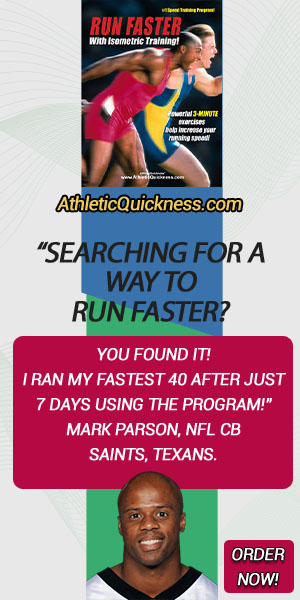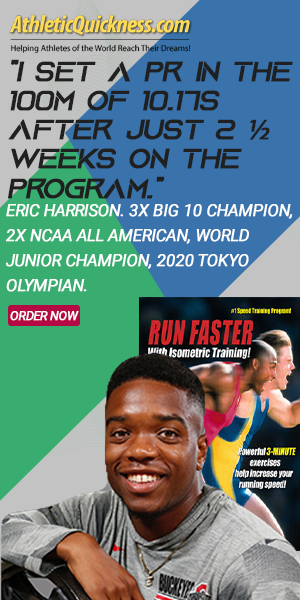If you are looking to sprint faster and increase your turnover rate, then you will need to start exercising your hip extensors to push and pull you forward during the running motion.
Your thigh’s position in relation to the hip joint determines if these muscles push or pull. If the thigh is in back, behind the hip, the hip extensors push in the power phase. If the thigh is in front of the hip, they will pull you forward as seen in Figure 1 below. Train these muscles for pushing and pulling and watch your running speed soar.

Figure 1. Thigh is flexed in front of hip so the hip extensors have to pull the thigh over the knee, forward.
The shortest of all three phases, the Pull Phase, starts where the Swing Phase ends. This is where your foot has just landed on the ground in front of you but your thigh is still flexed in front of you. See Figure 5-1a.
As the phase continues, the entire thigh is being pulled over the knee as seen in Figures 5-1b and 5-1c. This is the main function of the hip extensor muscles in this position. The Pull Phase ends when the top of your thigh has been pulled forward to a point where it is now perpendicular to the ground. See Figure 5-1d.
Note: Figure 5-1d is also the start of another Push Phase where the thigh is perpendicular to the ground and so the entire running motion is set to repeat itself again for the right leg.

From the moment you land on your right foot, the hip extensors located in the back of your thigh and buttocks, get stretched as seen in Figure 6.

The Pull Phase obviously involves a pulling-type of force. Again, pulling forces are forces that cause motion toward the source of the force. The source of the force here are the hip extensor muscles located in the back of the right buttocks and thigh.
But with the right leg and thigh now in front of the hip joint, the stretched hip extensors located in the back will have to pull so that the thigh carries forward, over the knee (Figure 5-1d).
Again, the hip extensor muscles are the Gluteus Maximus, Semimembranosus, Semitendinosus and Biceps Femoris (long head). As a side note, the short head of the Biceps Femoris does not cross the hip joint and therefore does not produce any action on it.
Now if you recall from the Push Phase, your hip extensors were used for a pushing action. This had to do with the position of your thigh in relation to the hip joint (socket), which was behind it during the Push Phase. But here in the Pull Phase, the thigh is in front of the hip joint and the hip extensors will therefore have to act by pulling on your thigh carrying you forward. See Figure 7.

This is a big difference in the action required by your hip extensors between these two phases but just like the hip flexors function in the Swing Phase, it is a motion that is rarely ever trained for. Just by training your hip extensors to pull, instead of push, will be of great benefit to you.
Again, think of it this way. If you are trying to improve your running speed, doesn’t it make sense to train for all three phases of the running motion? But if you continually spend all your time on training for just one phase, you are leaving behind upwards of 2/3’s of your training that is required for you to become faster.
The good news for you is that if this is really the case, then you have a huge reservoir of untapped muscular energy just waiting to be released!
Summary of the Running Motion: One Push, Two Pulls
As you can see from the description of the running motion, it involves a lot more than just pushing. In fact, of the three phases, only one of them involves pushing, the other two involves pulling with your hip flexors (Swing Phase, or stride) and pulling with your hip extensors (Pull Phase).
As a general rule then, to help you determine what phase of running you are in, consider the following: If your foot is on the ground, and your thigh is behind you, you are in the Push Phase. If your foot is on the ground, and your thigh is in front of you, you are in the Pull Phase. And if your foot is off the ground, you are in the Swing Phase.
So, what is the best way to train your hip flexors and hip extensors to pull? Well, at least one extremely efficient way is to use the resistance band with an isometric training strategy. If you haven’t had a chance to try one of our speed training exercises using the resistance band, then might we suggest now is the time to give it a try.
Like most people, what you will find on your very first attempt with an exercise like this is that these muscles have never ever been properly trained before. The amount of tension that you will be able to generate with our hip flexor exercise is almost unbelievable.
When you consider how long and how strong these muscles are along with their purpose in the running motion, you will probably be left wondering why you never tried something like this before.
But the good news is that the exercise works very fast and within a few days, you should start to see a measurable difference in your running speed.
And if you think you are fast after trying just one of our exercises, just think how quick you will become if you did the whole program!



